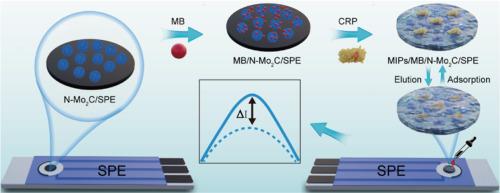Multifunctional paper-based platform with CuCo2O4 nanozyme and MB/N-Mo2C composites for dual-mode detection of inflammatory biomarkers
IF 14.3
1区 材料科学
Q1 MATERIALS SCIENCE, MULTIDISCIPLINARY
引用次数: 0
Abstract
C-reactive protein (CRP) is a critical biomarker for inflammation, extensively utilized in clinical diagnostics, especially in orthopedics for monitoring inflammation and assessing treatment efficacy. Developing portable and cost-effective methods for CRP detection is essential for facilitating point-of-care diagnostics in clinical practice. In this study, we developed a portable, dual-modal paper-based microfluidic device designed for the selective and highly sensitive detection of CRP in human serum. This innovative platform employs molecular imprinting technology, utilizing CRP as a template to synthesize molecularly imprinted polymers (MIPs) that create selective recognition sites on the surface of the material. The MIPs are combined with methylene blue (MB)-modified N-Mo2C and peroxidase-like CuCo2O4 nanozyme, enabling both electrochemical and colorimetric sensing. Additionally, a rotating valve is incorporated into the device to control the flow direction of reagents, preventing interference between the sensing pathways. Our results demonstrate that the platform exhibits excellent selectivity, repeatability, and stability for CRP detection. Further testing with real samples confirmed the reliability and practicality of this method. This system offers a portable, rapid, and reliable approach to CRP detection, with significant potential for point-of-care diagnostics. Moreover, it presents a promising tool for the early diagnosis and monitoring of orthopedic inflammation, particularly in resource-limited environments.

基于CuCo2O4纳米酶和MB/N-Mo2C复合材料的多功能纸质平台,用于炎症生物标志物的双模式检测
c -反应蛋白(CRP)是炎症的重要生物标志物,广泛应用于临床诊断,特别是骨科中监测炎症和评估治疗效果。开发便携式和具有成本效益的CRP检测方法对于促进临床实践中的护理点诊断至关重要。在这项研究中,我们开发了一种便携式、双峰纸基微流控装置,用于选择性和高灵敏度地检测人血清中的CRP。这个创新的平台采用分子印迹技术,利用CRP作为模板合成分子印迹聚合物(MIPs),在材料表面产生选择性识别位点。mip与亚甲基蓝(MB)修饰的N-Mo2C和过氧化物酶样CuCo2O4纳米酶结合,实现电化学和比色传感。此外,在所述装置中还包括一个旋转阀,以控制试剂的流动方向,防止在所述传感路径之间的干扰。我们的研究结果表明,该平台对CRP检测具有出色的选择性、可重复性和稳定性。通过对实际样品的进一步测试,验证了该方法的可靠性和实用性。该系统提供了一种便携式、快速、可靠的CRP检测方法,具有重大的即时诊断潜力。此外,它为骨科炎症的早期诊断和监测提供了一个很有前途的工具,特别是在资源有限的环境中。
本文章由计算机程序翻译,如有差异,请以英文原文为准。
求助全文
约1分钟内获得全文
求助全文
来源期刊

Journal of Materials Science & Technology
工程技术-材料科学:综合
CiteScore
20.00
自引率
11.00%
发文量
995
审稿时长
13 days
期刊介绍:
Journal of Materials Science & Technology strives to promote global collaboration in the field of materials science and technology. It primarily publishes original research papers, invited review articles, letters, research notes, and summaries of scientific achievements. The journal covers a wide range of materials science and technology topics, including metallic materials, inorganic nonmetallic materials, and composite materials.
 求助内容:
求助内容: 应助结果提醒方式:
应助结果提醒方式:


